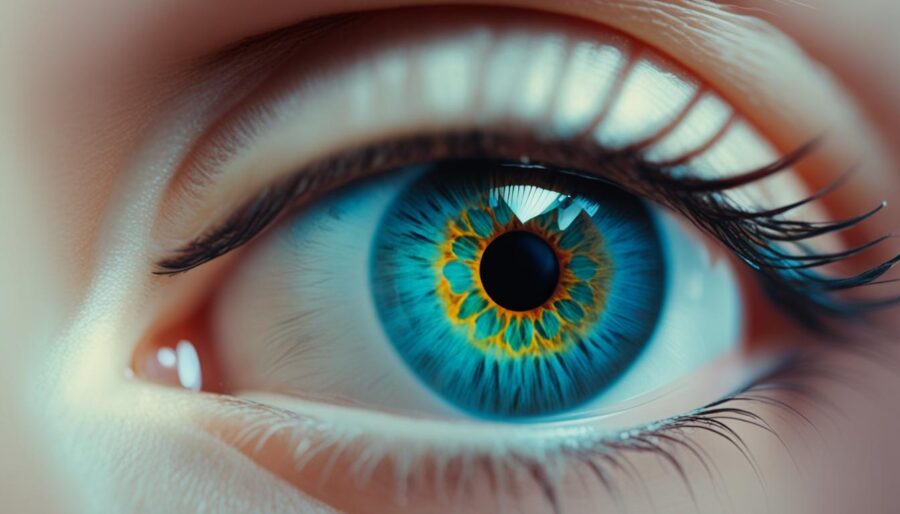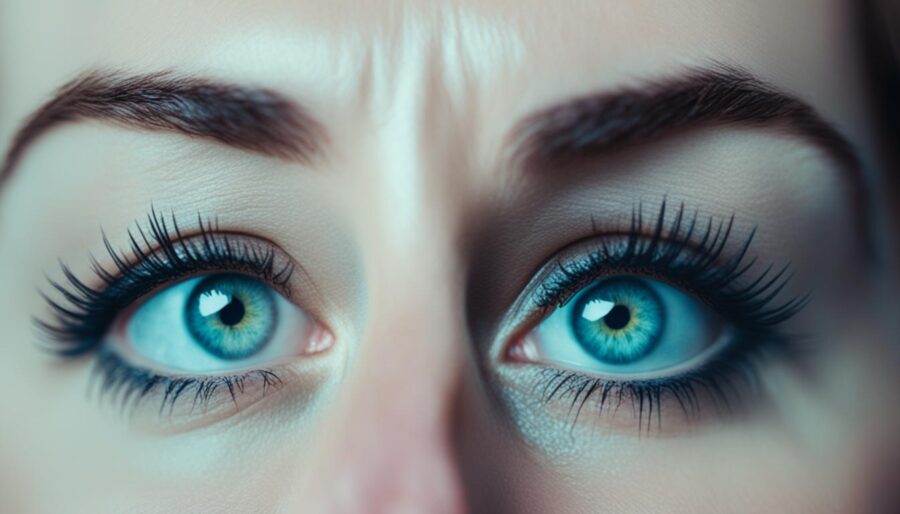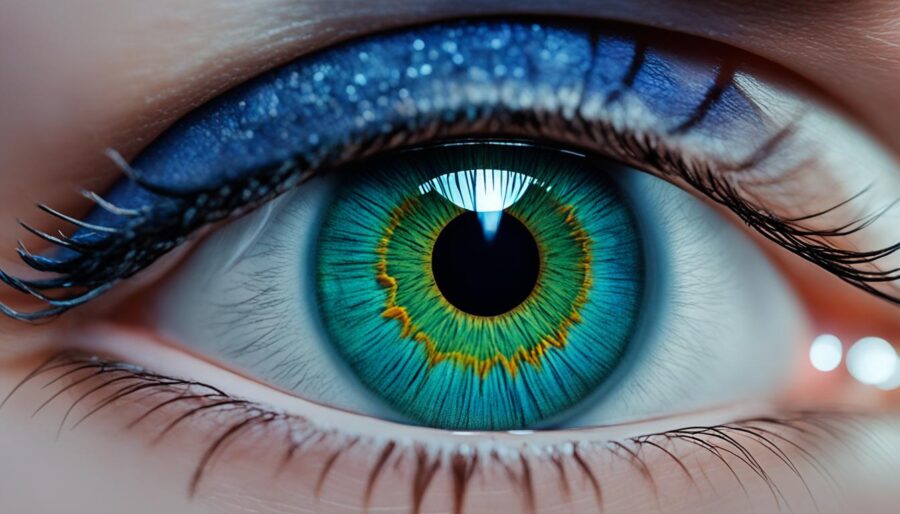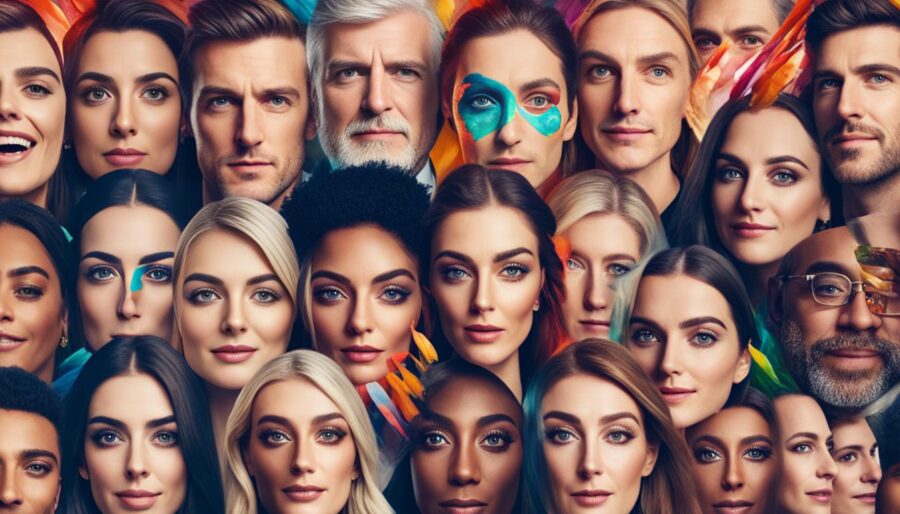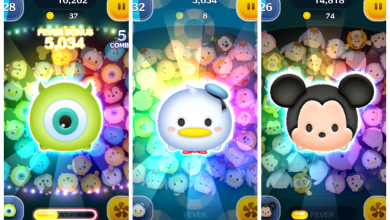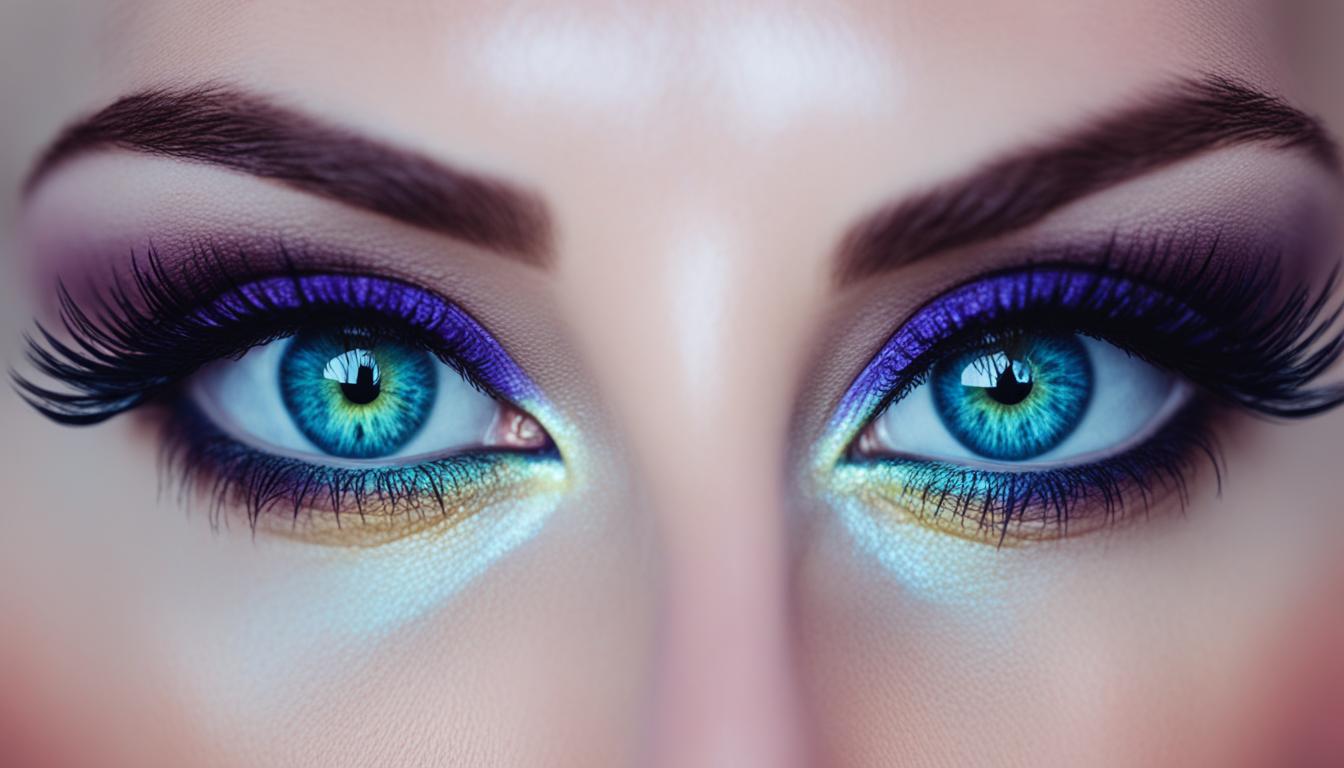
Did you know that rare eye colors can have a profound impact on an individual’s psychological well-being? Having a unique eye color goes beyond mere aesthetics and can shape various aspects of a person’s life, from social interactions to self-identity and mental health.
In this article, we will explore the top 10 psychological effects of having a rare eye color, revealing the intriguing and sometimes unexpected ways in which eye color can influence our thoughts, emotions, and relationships.
Key Takeaways:
- Rare eye colors can attract increased attention and curiosity from others, leading to both positive and negative psychological impacts.
- Having a rare eye color can contribute to an individual’s sense of individuality and self-identity, allowing them to embrace their uniqueness.
- Eye color can influence first impressions, social dynamics, and perceived attractiveness, shaping an individual’s social interactions and relationships.
- Stereotypes and misconceptions surrounding rare eye colors can affect an individual’s self-esteem and self-worth.
- Rare eye colors can have an impact on an individual’s psychological well-being and self-esteem, requiring coping strategies and support.
Rare eye colors are a unique and distinct characteristic that sets individuals apart from the majority with common eye colors. The fascination with rare eye colors in society often leads to increased attention and curiosity towards individuals with these unique traits.
This attention can have both positive and negative psychological impacts on individuals, shaping their sense of self-identity and influencing social interactions. Understanding the potential psychological effects of having a rare eye color is crucial in promoting self-acceptance, navigating stereotypes, and cultivating positive mental well-being.
The Uniqueness of Rare Eye Colors
Rare eye colors are a visual representation of individuality, highlighting a person’s distinctiveness among others. Not only are these eye colors visually captivating, but they also signify a genetic rarity that is fascinating to both the individual and those around them.
The uniqueness of rare eye colors sparks intrigue and curiosity, making the individuals who possess them stand out in the crowd. The ethereal quality of rare eye colors adds an element of mystery and allure, captivating the attention of others.
The Fascination with Rare Eye Colors in Society
Society has long been fascinated by rare eye colors and their inherent beauty. These eye colors defy the norm and challenge conventional notions of attractiveness, making individuals with rare eye colors intriguing and captivating.
The fascination with rare eye colors extends beyond their physical appearance, as they often symbolize uniqueness, depth, and even a touch of magic. The allure of rarity drives curiosity and interest, leading people to inquire about the origins and significance of these unique eye colors.
The Potential Psychological Impact of Having a Rare Eye Color
Having a rare eye color can have a profound psychological impact on individuals. The attention and curiosity that accompany rare eye colors can evoke a range of emotions and responses. Some individuals may feel empowered and confident, embracing their uniqueness and using it as a source of pride.
Others may experience feelings of self-consciousness or pressure to conform to societal expectations. The potential psychological effects of having a rare eye color can influence an individual’s self-identity, self-esteem, and overall mental well-being.
1. Increased Attention and Curiosity
Having a rare eye color inevitably attracts increased attention and curiosity from others. The unique and captivating appearance of rare eye colors often leads to stares, questions, and comments from people who are intrigued by their novelty. Individuals with rare eye colors may find themselves at the center of attention in social interactions, whether they welcome it or not.
This constant scrutiny can have a significant psychological impact on individuals, shaping their self-confidence, self-image, and overall well-being.
One of the main factors contributing to the increased attention towards individuals with rare eye colors is the novelty factor. Rare eye colors, such as shimmering violet or striking amber, are less common than the traditional brown, blue, or green eyes.
As a result, people tend to be fascinated by the distinctiveness and uncommonness of these eye colors. The allure of rarity sparks curiosity in others, prompting them to inquire about the genetic origins, maintenance, and personal experiences associated with having a rare eye color.
Dealing with the constant stares, questions, and comments from others regarding their rare eye color can be both rewarding and challenging for individuals.
While some individuals may enjoy the attention and appreciate the opportunity to share their unique story, others may find it overwhelming or intrusive. The psychological impact of constant attention should not be underestimated, as it can affect an individual’s self-confidence, self-image, and overall well-being.
2. Sense of Individuality and Self-Identity
Rare Eye Color as a Defining Characteristic
Having a rare eye color is a unique and defining characteristic that sets individuals apart from others. While common eye colors like brown and blue are widely seen, rare eye colors like amber, green, or gray are less common and instantly draw attention.
The rarity of their eye color becomes a defining feature that contributes to their individuality and uniqueness.
The Role of Eye Color in Shaping Self-Perception
Eye color plays a significant role in shaping an individual’s self-perception and image. How individuals view themselves and how they believe others perceive them can be influenced by their eye color.
When someone possesses a rare eye color, they often view themselves as distinctive and special. They recognize their eye color as a defining aspect of their identity, influencing their overall self-perception and self-image.
Embracing Uniqueness and Developing Self-Confidence
Embracing their rare eye color is an essential step in developing self-confidence and embracing their uniqueness. Rather than feeling self-conscious or trying to conform to societal norms, individuals with rare eye colors can celebrate their distinctiveness.
By accepting and highlighting their unique trait, they can cultivate self-confidence and pride. Embracing their rare eye color contributes to a positive psychological impact and empowers individuals to fully embrace and appreciate their individuality.
| Rare Eye Colors | Description |
|---|---|
| Amber | Amber eyes have a golden or yellowish hue, often resembling the color of amber. |
| Green | Green eyes are characterized by a unique blend of blue and yellow pigments, creating a captivating green shade. |
| Gray | Gray eyes have a unique combination of blue, green, and gray pigments, resulting in a distinctive gray color. |
3. Social Interactions and Relationships
Rare eye colors can have a significant impact on social interactions and relationships. The color of an individual’s eyes often contributes to the first impressions they make on others, influencing initial judgments and perceptions.
Additionally, the perceived attractiveness of individuals with rare eye colors can shape social dynamics and even impact romantic relationships.
When it comes to social interactions, the unique eye color of an individual can be a conversation starter and provoke curiosity from others. This curiosity can lead to increased attention and interest from peers, which can have both positive and negative effects on the individuals with rare eye colors.
While some may enjoy the spotlight, others may find it overwhelming or intrusive, causing potential psychological effects such as self-consciousness or heightened self-awareness.
Moreover, the perceived attractiveness of individuals with rare eye colors can also have an influence on social interactions. People with distinct eye colors are often seen as more attractive, which can affect the way others respond to them and the opportunities they have in forming social connections.
Navigating social dynamics can be a unique experience for individuals with rare eye colors. It requires a delicate balance between embracing one’s uniqueness and fitting into social norms.
Understanding the impact of eye color on social interactions can help individuals with rare eye colors navigate these dynamics with confidence and authenticity, allowing them to build genuine connections based on their unique traits and personality.
4. Stereotypes and Misconceptions
Having a rare eye color often leads to the perpetuation of stereotypes and misconceptions. These false beliefs are often rooted in common myths and legends surrounding rare eye colors.
These myths create unrealistic expectations and can have a negative psychological impact on individuals with these unique traits.
Common Myths and Legends Surrounding Rare Eye Colors
There are several myths and legends surrounding rare eye colors, contributing to the stereotypes and misconceptions that individuals with these eye colors often face. Some of the common myths include:
- Only certain ethnic groups or nationalities can have rare eye colors. This myth falsely assumes that rare eye colors are exclusive to specific racial or ethnic backgrounds, disregarding the fact that eye color genetics can vary across individuals within any population.
- Individuals with rare eye colors must possess supernatural or mystical powers. This myth often romanticizes the unique eye colors, attributing extraordinary abilities or traits to individuals solely based on their eye color.
- Rare eye colors are incredibly rare and unusual. While rare, these eye colors are not as uncommon as some myths suggest. They occur naturally and reflect the natural diversity in eye color genetics.
Dealing with Stereotypes and Preconceived Notions
Individuals with rare eye colors often find themselves dealing with stereotypes and preconceived notions based on these myths. They may encounter assumptions and judgments from others that are rooted in these misconceptions.
These stereotypes can impact their self-esteem, self-worth, and overall psychological well-being.
It is crucial for individuals with rare eye colors to navigate and challenge these stereotypes effectively. By educating others about the reality of rare eye colors and providing accurate information, it is possible to break down these preconceived notions and promote a more inclusive understanding of eye color diversity.
Breaking Free from Limiting Beliefs and Expectations
In order to fully embrace the beauty and uniqueness of rare eye colors, it is essential for individuals to break free from the limiting beliefs and expectations imposed by these stereotypes. This involves challenging societal norms, embracing self-acceptance, and celebrating the diversity of eye colors.
Breaking free from these limiting beliefs requires individuals to recognize their own worth beyond their eye color. It involves developing a positive self-image and cultivating self-confidence based on their unique traits and qualities.
By embracing their rare eye color as a distinguishing and beautiful feature, individuals can overcome the psychological impact of stereotypes and misconceptions.
5. Psychological Well-Being and Self-Esteem
The influence of rare eye color on an individual’s psychological well-being and self-esteem is significant. Having a unique eye color can impact one’s sense of self-worth and self-perception, leading to feelings of being different or misunderstood.
Coping with these emotions is essential for embracing one’s uniqueness and developing a positive self-image. Individuals with rare eye colors may face challenges in accepting and embracing their distinctiveness, which can affect their overall psychological well-being.
However, by cultivating a positive self-image and embracing their uniqueness, individuals can foster a healthy sense of self and build resilience. Promoting mental well-being and self-esteem among individuals with rare eye colors is crucial for their psychological growth and self-acceptance.
| Psychological Well-Being and Self-Esteem | Coping with Feelings of Being Different | Cultivating a Positive Self-Image and Embracing Uniqueness |
|---|---|---|
| Impacted by rare eye color | Challenges acceptance and self-perception | Fosters a healthy sense of self |
| Influences self-worth and self-esteem | Can affect overall psychological well-being | Builds resilience |
| Encourages self-acceptance and self-love |
6. Cultural and Societal Perceptions
Cultural and societal perceptions play a significant role in how rare eye colors are perceived. Eye color holds cultural significance in different societies and often influences the prevailing beauty standards regarding desirability and attractiveness.
It is essential to challenge these norms and stereotypes to celebrate the diversity of eye colors and promote inclusivity.
The Significance of Eye Color in Different Cultures
In various cultures around the world, eye color carries symbolic meanings and cultural interpretations. For example, in some cultures, specific eye colors are associated with good luck, spirituality, or even supernatural powers.
Understanding the significance of eye color in different cultures can provide valuable insights into the diverse perspectives surrounding rare eye colors.
Societal Beauty Standards and Rare Eye Colors
Societal beauty standards heavily influence the perceived attractiveness of certain eye colors. In some societies, there may be a preference for specific eye colors that align with the prevailing beauty ideals.
This can create challenges for individuals with rare eye colors who may feel their unique traits do not conform to societal expectations. It is important to recognize and challenge these beauty standards to foster a more inclusive and accepting society.
Challenging Norms and Celebrating Diversity
Challenging societal norms and stereotypes surrounding eye color is vital for celebrating the diversity of rare eye colors. By embracing and celebrating the unique traits of rare eye colors, we can promote inclusivity and acceptance.
Recognizing that beauty comes in all forms and celebrating the diversity of eye colors contributes to a more positive and inclusive viewpoint.
| Cultural Perception | Eye Color Symbolism |
|---|---|
| Asian cultures | Black and brown eye colors traditionally symbolize wisdom and intelligence. |
| Scandinavian cultures | Blue and green eye colors are often associated with purity and beauty. |
| Middle Eastern cultures | Brown and hazel eye colors are considered a mark of beauty and depth. |
| African cultures | Dark brown eye color is often seen as a symbol of strength and resilience. |
7. Representation in Media and Pop Culture
Representation of individuals with rare eye colors in media and pop culture plays a significant role in shaping self-perception and societal views. The portrayal of characters with rare eye colors can impact how individuals with these unique traits see themselves and how others perceive them.
Advocating for accurate and diverse representation is crucial for promoting inclusivity and breaking down stereotypes. By advocating for accurate representation in media and pop culture, individuals with rare eye colors can foster a sense of belonging and acceptance.
Media and pop culture have a powerful influence on our society’s perception of beauty and normality. When characters with rare eye colors are portrayed accurately and positively, it not only validates the experiences of individuals with these eye colors but also challenges societal norms and expectations.
Accurate representation in media and pop culture allows individuals with rare eye colors to see themselves represented in a wider range of narratives, giving them a sense of visibility and validation. It also helps to break down stereotypes and misconceptions surrounding rare eye colors, promoting a more inclusive and accepting society.
Advocacy for diverse representation involves encouraging filmmakers, TV show creators, and other media professionals to include characters with rare eye colors in their stories. By doing so, they can contribute to a more realistic and diverse portrayal of human experiences.
Advocating for accurate and diverse representation also extends to supporting initiatives and campaigns that promote inclusivity and challenge societal beauty standards.
It involves raising awareness about the importance of diversity in media and pop culture, and actively demanding fair and accurate representation of individuals with rare eye colors.
| Rare Eye Color Representation in Media and Pop Culture | Impact on Self-Perception and Societal Views | Advocating for Accurate and Diverse Representation |
|---|---|---|
| Inclusion of characters with rare eye colors in movies, TV shows, and books | Validation and visibility for individuals with rare eye colors | Encouraging filmmakers and media professionals to include diverse eye colors in their stories |
| Breaking down stereotypes and misconceptions surrounding rare eye colors | Challenging societal norms and expectations | Raising awareness about the importance of diversity in media and pop culture |
| Representation that reflects the diversity of human experiences | Promoting inclusivity and acceptance | Supporting initiatives and campaigns that advocate for fair and accurate representation |
8. Coping Strategies and Support
Having coping strategies and support systems in place is essential for individuals with rare eye colors.
The unique challenges that come with having a rare eye color can have a significant psychological impact, but there are strategies that can help individuals navigate these challenges and develop resilience and emotional intelligence.
Developing Resilience and Emotional Intelligence
Developing resilience is crucial for individuals with rare eye colors to cope with the psychological effects they may experience. Resilience allows individuals to bounce back from adversity and face challenges with inner strength and determination.
By cultivating emotional intelligence, individuals can better understand and manage their emotions, which can positively impact their psychological well-being.
Seeking Support from Family, Friends, and Professionals
Seeking support from loved ones can provide individuals with rare eye colors with a strong foundation of understanding and empathy.
Family and friends can offer a listening ear, reassurance, and guidance. Additionally, professionals such as therapists or counselors can provide specialized support and help individuals navigate the psychological challenges specific to their rare eye color.
Connecting with Others Who Have Rare Eye Colors
Connecting with others who have rare eye colors can create a sense of community and understanding. By sharing experiences, individuals with rare eye colors can find comfort and support in knowing that they are not alone.
Online communities, support groups, or social media platforms can serve as spaces where individuals can connect and exchange coping strategies, stories, and advice.
9. Celebrating Uniqueness and Diversity
Celebrating the beauty of rare eye colors and embracing uniqueness is a vital aspect of the psychological journey for individuals who possess this rare trait.
Rather than perceiving their eye color as an anomaly, individuals should view it as a precious gift that sets them apart from others.
By promoting acceptance and inclusivity, we can create a society that celebrates the diversity of eye colors, fostering a sense of belonging and self-acceptance among individuals with unique eye colors. Embracing their own distinctiveness not only empowers individuals with rare eye colors but also inspires others to embrace and celebrate their own unique qualities.
Through this celebration of uniqueness, we can create a culture that values diversity, breaking free from conventional beauty standards and embracing the extraordinary nature of rare eye colors. By encouraging others to appreciate and celebrate their own distinctiveness, we promote self-acceptance and inspire others to find beauty in their differences.
| Benefits of Celebrating Uniqueness and Diversity | Inclusive Society | Emotional Well-being |
|---|---|---|
| 1. Promotes acceptance and inclusivity | 1. Fosters a sense of belonging | 1. Enhances self-esteem and self-image |
| 2. Inspires others to embrace their distinctiveness | 2. Breaks free from conventional beauty standards | 2. Encourages self-acceptance and authenticity |
| 3. Cultivates a culture that values diversity | 3. Celebrates uniqueness and individuality | 3. Inspires others to appreciate their own differences |
10. The Importance of Self-Love and Acceptance
Self-love and acceptance are vital for individuals with rare eye colors to cultivate a strong sense of psychological well-being. Embracing their unique eye color and journey requires cultivating self-compassion and inner strength.
Cultivating Self-Compassion and Inner Strength
Self-compassion is key to navigating the challenges that come with having a rare eye color. By treating themselves with kindness and understanding, individuals can develop resilience and foster a positive mindset.
Focusing on Personal Growth and Development
Personal growth and development play a significant role in embracing the psychological journey of having a rare eye color. By investing in their personal growth, individuals can build self-confidence, resilience, and a strong sense of self.
| Benefits of Self-Love and Acceptance | How to Cultivate Self-Love and Acceptance |
|---|---|
|
|
Embracing the Psychological Journey of Having a Rare Eye Color
The psychological journey of having a rare eye color is unique to each individual. By embracing this journey, individuals can find strength, authenticity, and a deep sense of self.
It is a journey of self-discovery and celebration of one’s rare and beautiful eye color.
Conclusion
Rare eye colors have a profound impact on individuals’ psychological well-being and various aspects of their lives. The complex psychological effects associated with having a rare eye color highlight the importance of promoting awareness, understanding, and support.
By recognizing and appreciating the beauty and uniqueness of rare eye colors, society can foster acceptance, inclusivity, and celebration.
Individuals with rare eye colors experience increased attention and curiosity from others, which can have both positive and negative psychological implications. Their eye color becomes a defining characteristic that shapes their sense of self-identity and influences social interactions.
It is crucial to navigate stereotypes, misconceptions, and the constant attention that comes with having a rare eye color, as these factors can impact self-esteem and overall well-being.
In promoting positive mental well-being for individuals with rare eye colors, it is essential to develop coping strategies and support systems. These can include building resilience, seeking support from loved ones and professionals, and connecting with others who share similar experiences.
By cultivating self-love, acceptance, and embracing their psychological journey, individuals with rare eye colors can navigate their lives with confidence and authenticity.
Awareness plays a vital role in creating an inclusive and accepting society. By understanding the psychological effects of rare eye colors, society can challenge stereotypes, break down barriers, and celebrate the beauty and uniqueness that comes with these characteristics. Promoting awareness and understanding contributes to positive mental well-being and empowers individuals to embrace their distinctiveness.
Frequently Asked Questions
Q: What are the top psychological effects of having a rare eye color?
A: The top psychological effects of having a rare eye color include increased attention and curiosity, a sense of individuality and self-identity, impacts on social interactions and relationships, dealing with stereotypes and misconceptions, influencing psychological well-being and self-esteem, cultural and societal perceptions, representation in media and pop culture, coping strategies and support, celebrating uniqueness and diversity, and the importance of self-love and acceptance.
Q: How does having a rare eye color affect attention and curiosity from others?
A: Individuals with rare eye colors often receive increased attention and curiosity from others due to the novelty factor of their unique appearance. This attention can range from stares and questions to comments and compliments. Some individuals may enjoy the attention, while others may find it overwhelming. Dealing with these reactions can have a significant psychological impact on self-confidence, self-image, and overall well-being.
Q: In what ways does having a rare eye color contribute to a sense of individuality and self-identity?
A: Rare eye color becomes a defining characteristic that sets individuals apart from the crowd, allowing them to embrace their uniqueness and develop a strong sense of self. Eye color can play a role in shaping self-perception and image, influencing how individuals view themselves and how they believe others perceive them. Embracing their rare eye color and developing self-confidence can have a positive psychological impact, empowering individuals to celebrate their distinctiveness.
Q: How does a rare eye color affect social interactions and relationships?
A: The eye color of an individual often contributes to the first impressions they make on others, influencing initial judgments and perceptions. The perceived attractiveness of individuals with rare eye colors can also shape social dynamics and influence romantic relationships. Understanding the impact of eye color on social interactions can help individuals with rare eye colors navigate these dynamics with confidence and authenticity.
Q: What stereotypes and misconceptions are associated with rare eye colors?
A: Rare eye colors often come with stereotypes and misconceptions perpetuated by common myths and legends. Individuals with rare eye colors may face preconceived notions based on these myths, which can have a negative psychological impact on their self-esteem and self-worth. Breaking free from these limiting beliefs is essential for embracing the true beauty and uniqueness of rare eye colors.
Q: How does having a rare eye color impact psychological well-being and self-esteem?
A: Rare eye color can impact self-worth and self-perception, leading to feelings of being different or misunderstood. Coping with these emotions and cultivating a positive self-image is crucial for embracing uniqueness and developing a healthy sense of self. Promoting mental well-being and self-esteem among individuals with rare eye colors is vital for their psychological growth and resilience.
Q: How do cultural and societal perceptions influence the way rare eye colors are viewed?
A: Eye color has cultural significance in different societies, and societal beauty standards often influence the desirability and attractiveness of certain eye colors. Challenging these norms and stereotypes is essential for celebrating the diversity of eye colors and promoting inclusivity. Understanding the cultural and societal perceptions surrounding rare eye colors can help individuals with these unique traits navigate their psychological journey with confidence and pride.
Q: What role does representation in media and pop culture play for individuals with rare eye colors?
A: The portrayal of characters with rare eye colors in media and pop culture can impact how individuals with these unique traits see themselves and how others perceive them. Advocating for accurate and diverse representation is crucial for promoting inclusivity and breaking down stereotypes. By advocating for accurate representation in media and pop culture, individuals with rare eye colors can foster a sense of belonging and acceptance.
Q: What coping strategies and support systems are recommended for individuals with rare eye colors?
A: Having coping strategies and support systems in place is essential for individuals with rare eye colors. Developing resilience and emotional intelligence can help individuals navigate the psychological challenges that come with their unique trait. Seeking support from family, friends, and professionals can provide valuable guidance and understanding. Additionally, connecting with others who have rare eye colors can provide a sense of community and shared experiences.
Q: How can individuals celebrate their uniqueness and diversity of rare eye colors?
A: Celebrating uniqueness and diversity is an essential aspect of the psychological journey for individuals with rare eye colors. Embracing their rare eye color as a gift and promoting acceptance and inclusivity can foster a sense of belonging and self-acceptance. By embracing their own uniqueness, individuals with rare eye colors can inspire others to celebrate their own distinctiveness and find beauty in their differences.
Q: How important is self-love and acceptance for individuals with rare eye colors?
A: Self-love and acceptance are crucial components of the psychological well-being of individuals with rare eye colors. Cultivating self-compassion and inner strength can help individuals navigate the challenges and embrace the unique journey that comes with their rare eye color. Focusing on personal growth and development allows individuals to build resilience, confidence, and a positive mindset. By embracing their psychological journey, individuals with rare eye colors can find strength and embrace their true selves.

